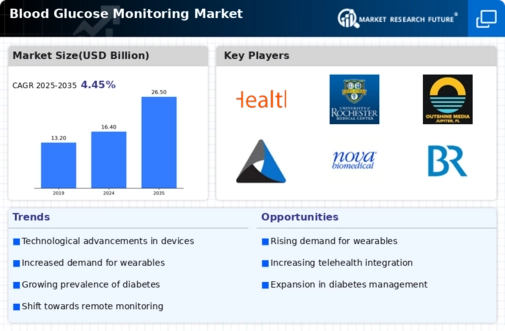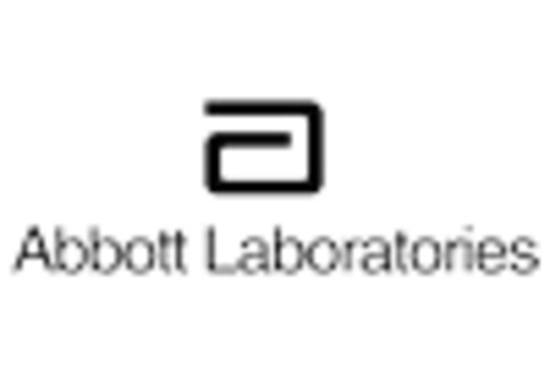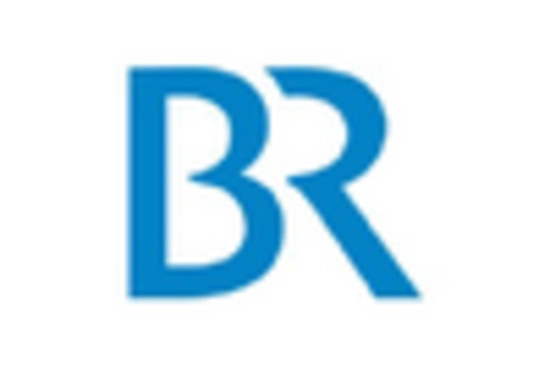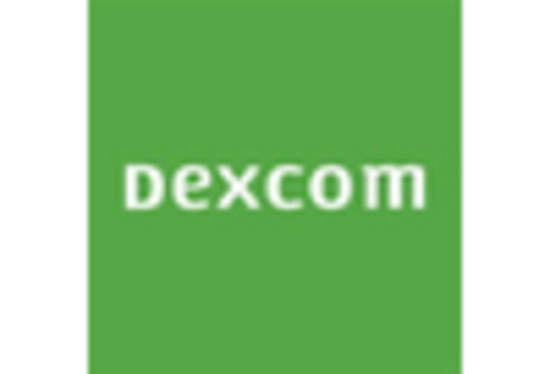Self-Monitoring Blood Glucose Devices
Continuous Glucose Monitoring Devices
Blood Glucose Test Strips
Lancets
Electrochemistry
Optical Method
Transdermal Monitoring
Hospitals
Homecare Settings
Ambulatory Surgical Centers
Diabetes Management
Obesity Management
Gestational Diabetes Monitoring
North America
Europe
South America
Asia Pacific
Middle East and Africa
North America Outlook (USD Billion, 2019-2035)
North America Blood Glucose Monitoring Market by Product Type
Self-Monitoring Blood Glucose Devices
Continuous Glucose Monitoring Devices
Blood Glucose Test Strips
Lancets
North America Blood Glucose Monitoring Market by Technology Type
Electrochemistry
Optical Method
Transdermal Monitoring
North America Blood Glucose Monitoring Market by End User Type
Hospitals
Homecare Settings
Ambulatory Surgical Centers
North America Blood Glucose Monitoring Market by Application Type
Diabetes Management
Obesity Management
Gestational Diabetes Monitoring
North America Blood Glucose Monitoring Market by Regional Type
US
Canada
US Outlook (USD Billion, 2019-2035)
US Blood Glucose Monitoring Market by Product Type
Self-Monitoring Blood Glucose Devices
Continuous Glucose Monitoring Devices
Blood Glucose Test Strips
Lancets
US Blood Glucose Monitoring Market by Technology Type
Electrochemistry
Optical Method
Transdermal Monitoring
US Blood Glucose Monitoring Market by End User Type
Hospitals
Homecare Settings
Ambulatory Surgical Centers
US Blood Glucose Monitoring Market by Application Type
Diabetes Management
Obesity Management
Gestational Diabetes Monitoring
CANADA Outlook (USD Billion, 2019-2035)
CANADA Blood Glucose Monitoring Market by Product Type
Self-Monitoring Blood Glucose Devices
Continuous Glucose Monitoring Devices
Blood Glucose Test Strips
Lancets
CANADA Blood Glucose Monitoring Market by Technology Type
Electrochemistry
Optical Method
Transdermal Monitoring
CANADA Blood Glucose Monitoring Market by End User Type
Hospitals
Homecare Settings
Ambulatory Surgical Centers
CANADA Blood Glucose Monitoring Market by Application Type
Diabetes Management
Obesity Management
Gestational Diabetes Monitoring
Europe Outlook (USD Billion, 2019-2035)
Europe Blood Glucose Monitoring Market by Product Type
Self-Monitoring Blood Glucose Devices
Continuous Glucose Monitoring Devices
Blood Glucose Test Strips
Lancets
Europe Blood Glucose Monitoring Market by Technology Type
Electrochemistry
Optical Method
Transdermal Monitoring
Europe Blood Glucose Monitoring Market by End User Type
Hospitals
Homecare Settings
Ambulatory Surgical Centers
Europe Blood Glucose Monitoring Market by Application Type
Diabetes Management
Obesity Management
Gestational Diabetes Monitoring
Europe Blood Glucose Monitoring Market by Regional Type
Germany
UK
France
Russia
Italy
Spain
Rest of Europe
GERMANY Outlook (USD Billion, 2019-2035)
GERMANY Blood Glucose Monitoring Market by Product Type
Self-Monitoring Blood Glucose Devices
Continuous Glucose Monitoring Devices
Blood Glucose Test Strips
Lancets
GERMANY Blood Glucose Monitoring Market by Technology Type
Electrochemistry
Optical Method
Transdermal Monitoring
GERMANY Blood Glucose Monitoring Market by End User Type
Hospitals
Homecare Settings
Ambulatory Surgical Centers
GERMANY Blood Glucose Monitoring Market by Application Type
Diabetes Management
Obesity Management
Gestational Diabetes Monitoring
UK Outlook (USD Billion, 2019-2035)
UK Blood Glucose Monitoring Market by Product Type
Self-Monitoring Blood Glucose Devices
Continuous Glucose Monitoring Devices
Blood Glucose Test Strips
Lancets
UK Blood Glucose Monitoring Market by Technology Type
Electrochemistry
Optical Method
Transdermal Monitoring
UK Blood Glucose Monitoring Market by End User Type
Hospitals
Homecare Settings
Ambulatory Surgical Centers
UK Blood Glucose Monitoring Market by Application Type
Diabetes Management
Obesity Management
Gestational Diabetes Monitoring
FRANCE Outlook (USD Billion, 2019-2035)
FRANCE Blood Glucose Monitoring Market by Product Type
Self-Monitoring Blood Glucose Devices
Continuous Glucose Monitoring Devices
Blood Glucose Test Strips
Lancets
FRANCE Blood Glucose Monitoring Market by Technology Type
Electrochemistry
Optical Method
Transdermal Monitoring
FRANCE Blood Glucose Monitoring Market by End User Type
Hospitals
Homecare Settings
Ambulatory Surgical Centers
FRANCE Blood Glucose Monitoring Market by Application Type
Diabetes Management
Obesity Management
Gestational Diabetes Monitoring
RUSSIA Outlook (USD Billion, 2019-2035)
RUSSIA Blood Glucose Monitoring Market by Product Type
Self-Monitoring Blood Glucose Devices
Continuous Glucose Monitoring Devices
Blood Glucose Test Strips
Lancets
RUSSIA Blood Glucose Monitoring Market by Technology Type
Electrochemistry
Optical Method
Transdermal Monitoring
RUSSIA Blood Glucose Monitoring Market by End User Type
Hospitals
Homecare Settings
Ambulatory Surgical Centers
RUSSIA Blood Glucose Monitoring Market by Application Type
Diabetes Management
Obesity Management
Gestational Diabetes Monitoring
ITALY Outlook (USD Billion, 2019-2035)
ITALY Blood Glucose Monitoring Market by Product Type
Self-Monitoring Blood Glucose Devices
Continuous Glucose Monitoring Devices
Blood Glucose Test Strips
Lancets
ITALY Blood Glucose Monitoring Market by Technology Type
Electrochemistry
Optical Method
Transdermal Monitoring
ITALY Blood Glucose Monitoring Market by End User Type
Hospitals
Homecare Settings
Ambulatory Surgical Centers
ITALY Blood Glucose Monitoring Market by Application Type
Diabetes Management
Obesity Management
Gestational Diabetes Monitoring
SPAIN Outlook (USD Billion, 2019-2035)
SPAIN Blood Glucose Monitoring Market by Product Type
Self-Monitoring Blood Glucose Devices
Continuous Glucose Monitoring Devices
Blood Glucose Test Strips
Lancets
SPAIN Blood Glucose Monitoring Market by Technology Type
Electrochemistry
Optical Method
Transdermal Monitoring
SPAIN Blood Glucose Monitoring Market by End User Type
Hospitals
Homecare Settings
Ambulatory Surgical Centers
SPAIN Blood Glucose Monitoring Market by Application Type
Diabetes Management
Obesity Management
Gestational Diabetes Monitoring
REST OF EUROPE Outlook (USD Billion, 2019-2035)
REST OF EUROPE Blood Glucose Monitoring Market by Product Type
Self-Monitoring Blood Glucose Devices
Continuous Glucose Monitoring Devices
Blood Glucose Test Strips
Lancets
REST OF EUROPE Blood Glucose Monitoring Market by Technology Type
Electrochemistry
Optical Method
Transdermal Monitoring
REST OF EUROPE Blood Glucose Monitoring Market by End User Type
Hospitals
Homecare Settings
Ambulatory Surgical Centers
REST OF EUROPE Blood Glucose Monitoring Market by Application Type
Diabetes Management
Obesity Management
Gestational Diabetes Monitoring
APAC Outlook (USD Billion, 2019-2035)
APAC Blood Glucose Monitoring Market by Product Type
Self-Monitoring Blood Glucose Devices
Continuous Glucose Monitoring Devices
Blood Glucose Test Strips
Lancets
APAC Blood Glucose Monitoring Market by Technology Type
Electrochemistry
Optical Method
Transdermal Monitoring
APAC Blood Glucose Monitoring Market by End User Type
Hospitals
Homecare Settings
Ambulatory Surgical Centers
APAC Blood Glucose Monitoring Market by Application Type
Diabetes Management
Obesity Management
Gestational Diabetes Monitoring
APAC Blood Glucose Monitoring Market by Regional Type
China
India
Japan
South Korea
Malaysia
Thailand
Indonesia
Rest of APAC
CHINA Outlook (USD Billion, 2019-2035)
CHINA Blood Glucose Monitoring Market by Product Type
Self-Monitoring Blood Glucose Devices
Continuous Glucose Monitoring Devices
Blood Glucose Test Strips
Lancets
CHINA Blood Glucose Monitoring Market by Technology Type
Electrochemistry
Optical Method
Transdermal Monitoring
CHINA Blood Glucose Monitoring Market by End User Type
Hospitals
Homecare Settings
Ambulatory Surgical Centers
CHINA Blood Glucose Monitoring Market by Application Type
Diabetes Management
Obesity Management
Gestational Diabetes Monitoring
INDIA Outlook (USD Billion, 2019-2035)
INDIA Blood Glucose Monitoring Market by Product Type
Self-Monitoring Blood Glucose Devices
Continuous Glucose Monitoring Devices
Blood Glucose Test Strips
Lancets
INDIA Blood Glucose Monitoring Market by Technology Type
Electrochemistry
Optical Method
Transdermal Monitoring
INDIA Blood Glucose Monitoring Market by End User Type
Hospitals
Homecare Settings
Ambulatory Surgical Centers
INDIA Blood Glucose Monitoring Market by Application Type
Diabetes Management
Obesity Management
Gestational Diabetes Monitoring
JAPAN Outlook (USD Billion, 2019-2035)
JAPAN Blood Glucose Monitoring Market by Product Type
Self-Monitoring Blood Glucose Devices
Continuous Glucose Monitoring Devices
Blood Glucose Test Strips
Lancets
JAPAN Blood Glucose Monitoring Market by Technology Type
Electrochemistry
Optical Method
Transdermal Monitoring
JAPAN Blood Glucose Monitoring Market by End User Type
Hospitals
Homecare Settings
Ambulatory Surgical Centers
JAPAN Blood Glucose Monitoring Market by Application Type
Diabetes Management
Obesity Management
Gestational Diabetes Monitoring
SOUTH KOREA Outlook (USD Billion, 2019-2035)
SOUTH KOREA Blood Glucose Monitoring Market by Product Type
Self-Monitoring Blood Glucose Devices
Continuous Glucose Monitoring Devices
Blood Glucose Test Strips
Lancets
SOUTH KOREA Blood Glucose Monitoring Market by Technology Type
Electrochemistry
Optical Method
Transdermal Monitoring
SOUTH KOREA Blood Glucose Monitoring Market by End User Type
Hospitals
Homecare Settings
Ambulatory Surgical Centers
SOUTH KOREA Blood Glucose Monitoring Market by Application Type
Diabetes Management
Obesity Management
Gestational Diabetes Monitoring
MALAYSIA Outlook (USD Billion, 2019-2035)
MALAYSIA Blood Glucose Monitoring Market by Product Type
Self-Monitoring Blood Glucose Devices
Continuous Glucose Monitoring Devices
Blood Glucose Test Strips
Lancets
MALAYSIA Blood Glucose Monitoring Market by Technology Type
Electrochemistry
Optical Method
Transdermal Monitoring
MALAYSIA Blood Glucose Monitoring Market by End User Type
Hospitals
Homecare Settings
Ambulatory Surgical Centers
MALAYSIA Blood Glucose Monitoring Market by Application Type
Diabetes Management
Obesity Management
Gestational Diabetes Monitoring
THAILAND Outlook (USD Billion, 2019-2035)
THAILAND Blood Glucose Monitoring Market by Product Type
Self-Monitoring Blood Glucose Devices
Continuous Glucose Monitoring Devices
Blood Glucose Test Strips
Lancets
THAILAND Blood Glucose Monitoring Market by Technology Type
Electrochemistry
Optical Method
Transdermal Monitoring
THAILAND Blood Glucose Monitoring Market by End User Type
Hospitals
Homecare Settings
Ambulatory Surgical Centers
THAILAND Blood Glucose Monitoring Market by Application Type
Diabetes Management
Obesity Management
Gestational Diabetes Monitoring
INDONESIA Outlook (USD Billion, 2019-2035)
INDONESIA Blood Glucose Monitoring Market by Product Type
Self-Monitoring Blood Glucose Devices
Continuous Glucose Monitoring Devices
Blood Glucose Test Strips
Lancets
INDONESIA Blood Glucose Monitoring Market by Technology Type
Electrochemistry
Optical Method
Transdermal Monitoring
INDONESIA Blood Glucose Monitoring Market by End User Type
Hospitals
Homecare Settings
Ambulatory Surgical Centers
INDONESIA Blood Glucose Monitoring Market by Application Type
Diabetes Management
Obesity Management
Gestational Diabetes Monitoring
REST OF APAC Outlook (USD Billion, 2019-2035)
REST OF APAC Blood Glucose Monitoring Market by Product Type
Self-Monitoring Blood Glucose Devices
Continuous Glucose Monitoring Devices
Blood Glucose Test Strips
Lancets
REST OF APAC Blood Glucose Monitoring Market by Technology Type
Electrochemistry
Optical Method
Transdermal Monitoring
REST OF APAC Blood Glucose Monitoring Market by End User Type
Hospitals
Homecare Settings
Ambulatory Surgical Centers
REST OF APAC Blood Glucose Monitoring Market by Application Type
Diabetes Management
Obesity Management
Gestational Diabetes Monitoring
South America Outlook (USD Billion, 2019-2035)
South America Blood Glucose Monitoring Market by Product Type
Self-Monitoring Blood Glucose Devices
Continuous Glucose Monitoring Devices
Blood Glucose Test Strips
Lancets
South America Blood Glucose Monitoring Market by Technology Type
Electrochemistry
Optical Method
Transdermal Monitoring
South America Blood Glucose Monitoring Market by End User Type
Hospitals
Homecare Settings
Ambulatory Surgical Centers
South America Blood Glucose Monitoring Market by Application Type
Diabetes Management
Obesity Management
Gestational Diabetes Monitoring
South America Blood Glucose Monitoring Market by Regional Type
Brazil
Mexico
Argentina
Rest of South America
BRAZIL Outlook (USD Billion, 2019-2035)
BRAZIL Blood Glucose Monitoring Market by Product Type
Self-Monitoring Blood Glucose Devices
Continuous Glucose Monitoring Devices
Blood Glucose Test Strips
Lancets
BRAZIL Blood Glucose Monitoring Market by Technology Type
Electrochemistry
Optical Method
Transdermal Monitoring
BRAZIL Blood Glucose Monitoring Market by End User Type
Hospitals
Homecare Settings
Ambulatory Surgical Centers
BRAZIL Blood Glucose Monitoring Market by Application Type
Diabetes Management
Obesity Management
Gestational Diabetes Monitoring
MEXICO Outlook (USD Billion, 2019-2035)
MEXICO Blood Glucose Monitoring Market by Product Type
Self-Monitoring Blood Glucose Devices
Continuous Glucose Monitoring Devices
Blood Glucose Test Strips
Lancets
MEXICO Blood Glucose Monitoring Market by Technology Type
Electrochemistry
Optical Method
Transdermal Monitoring
MEXICO Blood Glucose Monitoring Market by End User Type
Hospitals
Homecare Settings
Ambulatory Surgical Centers
MEXICO Blood Glucose Monitoring Market by Application Type
Diabetes Management
Obesity Management
Gestational Diabetes Monitoring
ARGENTINA Outlook (USD Billion, 2019-2035)
ARGENTINA Blood Glucose Monitoring Market by Product Type
Self-Monitoring Blood Glucose Devices
Continuous Glucose Monitoring Devices
Blood Glucose Test Strips
Lancets
ARGENTINA Blood Glucose Monitoring Market by Technology Type
Electrochemistry
Optical Method
Transdermal Monitoring
ARGENTINA Blood Glucose Monitoring Market by End User Type
Hospitals
Homecare Settings
Ambulatory Surgical Centers
ARGENTINA Blood Glucose Monitoring Market by Application Type
Diabetes Management
Obesity Management
Gestational Diabetes Monitoring
REST OF SOUTH AMERICA Outlook (USD Billion, 2019-2035)
REST OF SOUTH AMERICA Blood Glucose Monitoring Market by Product Type
Self-Monitoring Blood Glucose Devices
Continuous Glucose Monitoring Devices
Blood Glucose Test Strips
Lancets
REST OF SOUTH AMERICA Blood Glucose Monitoring Market by Technology Type
Electrochemistry
Optical Method
Transdermal Monitoring
REST OF SOUTH AMERICA Blood Glucose Monitoring Market by End User Type
Hospitals
Homecare Settings
Ambulatory Surgical Centers
REST OF SOUTH AMERICA Blood Glucose Monitoring Market by Application Type
Diabetes Management
Obesity Management
Gestational Diabetes Monitoring
MEA Outlook (USD Billion, 2019-2035)
MEA Blood Glucose Monitoring Market by Product Type
Self-Monitoring Blood Glucose Devices
Continuous Glucose Monitoring Devices
Blood Glucose Test Strips
Lancets
MEA Blood Glucose Monitoring Market by Technology Type
Electrochemistry
Optical Method
Transdermal Monitoring
MEA Blood Glucose Monitoring Market by End User Type
Hospitals
Homecare Settings
Ambulatory Surgical Centers
MEA Blood Glucose Monitoring Market by Application Type
Diabetes Management
Obesity Management
Gestational Diabetes Monitoring
MEA Blood Glucose Monitoring Market by Regional Type
GCC Countries
South Africa
Rest of MEA
GCC COUNTRIES Outlook (USD Billion, 2019-2035)
GCC COUNTRIES Blood Glucose Monitoring Market by Product Type
Self-Monitoring Blood Glucose Devices
Continuous Glucose Monitoring Devices
Blood Glucose Test Strips
Lancets
GCC COUNTRIES Blood Glucose Monitoring Market by Technology Type
Electrochemistry
Optical Method
Transdermal Monitoring
GCC COUNTRIES Blood Glucose Monitoring Market by End User Type
Hospitals
Homecare Settings
Ambulatory Surgical Centers
GCC COUNTRIES Blood Glucose Monitoring Market by Application Type
Diabetes Management
Obesity Management
Gestational Diabetes Monitoring
SOUTH AFRICA Outlook (USD Billion, 2019-2035)
SOUTH AFRICA Blood Glucose Monitoring Market by Product Type
Self-Monitoring Blood Glucose Devices
Continuous Glucose Monitoring Devices
Blood Glucose Test Strips
Lancets
SOUTH AFRICA Blood Glucose Monitoring Market by Technology Type
Electrochemistry
Optical Method
Transdermal Monitoring
SOUTH AFRICA Blood Glucose Monitoring Market by End User Type
Hospitals
Homecare Settings
Ambulatory Surgical Centers
SOUTH AFRICA Blood Glucose Monitoring Market by Application Type
Diabetes Management
Obesity Management
Gestational Diabetes Monitoring
REST OF MEA Outlook (USD Billion, 2019-2035)
REST OF MEA Blood Glucose Monitoring Market by Product Type
Self-Monitoring Blood Glucose Devices
Continuous Glucose Monitoring Devices
Blood Glucose Test Strips
Lancets
REST OF MEA Blood Glucose Monitoring Market by Technology Type
Electrochemistry
Optical Method
Transdermal Monitoring
REST OF MEA Blood Glucose Monitoring Market by End User Type
Hospitals
Homecare Settings
Ambulatory Surgical Centers
REST OF MEA Blood Glucose Monitoring Market by Application Type
Diabetes Management
Obesity Management
Gestational Diabetes Monitoring









Leave a Comment